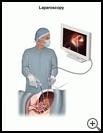
Endometriosis
What is endometriosis?
Endometriosis is when tissue that forms the lining of the uterus grows outside of the uterus. The uterus is the muscular organ at the top of the vagina. Babies grow in the uterus, and menstrual blood comes from the uterus.
The tissue most often grows around the ovaries, fallopian tubes, outside surface of the uterus, and lining of the pelvis. It may also grow in other areas, such as the bladder, rectum, or intestines. The tissue responds to the hormones of your menstrual cycle. It bleeds each month just like the lining of the uterus. However, when the tissue is not in the uterus, the blood has no way to leave the body. It can cause irritation, swelling, pain, and scar tissue. The scar tissue may cause organs to stick together.
Endometriosis can get worse as you get older until you reach menopause. It usually goes away after menopause. Symptoms can also get better with a pregnancy, but this improvement may not last. Endometriosis can make it hard to get pregnant.
What can I expect in the hospital?
You may need to stay in the hospital because you need surgery to diagnose or treat endometriosis. Several things may be done while you are in the hospital to monitor, test, and treat your condition. They include:
Monitoring
- You will be checked often by the hospital staff.
- Your heart rate, blood pressure, and temperature will be checked regularly.
- Your blood oxygen level may be monitored by a sensor that is attached to your finger or earlobe.
Testing
Testing may include:
- Blood tests to check for infection or blood loss
- A blood test to check for a certain protein (cancer antigen 125 or CA-125) that may be high in women with severe endometriosis
- Pelvic exam: Your healthcare provider will gently put a small tool called a speculum into your vagina to hold the vaginal walls open during the exam. Your provider will then put 1 or 2 lubricated, gloved fingers in your vagina and a hand on your abdomen to feel and check the size and shape of your uterus and ovaries.
- Ultrasound scan: Sound waves and their echoes are passed through your body from a small device that is held against your skin to create pictures of the inside of the abdomen and pelvis.
- Computed tomography (CT) scan: A series of X-rays is taken from different angles and arranged by a computer to show thin cross sections of the abdomen and pelvis.
Treatment
The treatment for endometriosis depends on how severe your symptoms are and how well you respond to treatment.
- You will have a small tube (IV catheter) inserted into a vein in your hand or arm. This will allow medicine to be given directly into your blood and to give you fluids, if needed.
- Your provider may prescribe medicine to:
- Treat pain
- Block hormones that help endometrial tissue to grow and bleed
- Your provider may recommend other types of therapy to help relieve pain, other symptoms, or side effects of treatment.
- You may need surgery to treat endometriosis. Surgery may include:
- Laparoscopy: A procedure in which a small lighted tube is put into the belly through a small cut to look at the organs and tissues inside the belly. A biopsy may be taken to help make a diagnosis. A biopsy is the removal of a small sample of tissue for testing. Your physician may also remove areas of endometriosis to reduce your symptoms.
- Hysterectomy: Surgery to remove your cervix and uterus. Tissue on the sides of your cervix may also be removed. In some cases, your fallopian tubes and ovaries are also removed.
What can I do to help?
- You will need to tell your healthcare team if you have new or worsening:
- Pelvic pain or cramping
- Belly pain
- Back pain
- Painful bowel movements, diarrhea, constipation
- Pain or burning during urination
- Urgent need to urinate often
- If you had surgery:
- Redness, swelling, pain, warmth, or drainage from your surgical wound
- Fever, chills, or muscle aches
- Ask questions about any medicine or treatment or information that you do not understand.
How long will I be in the hospital?
How long you stay in the hospital depends on many things, such as your general health, why you are in the hospital, and the treatment you need. Talk with your provider about how long your stay may be.
Last modified: 2016-01-26
Last reviewed: 2016-01-26


